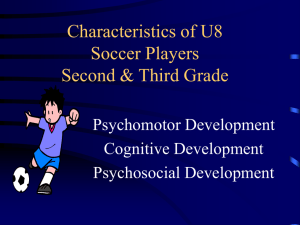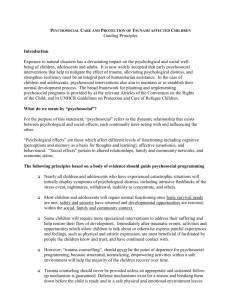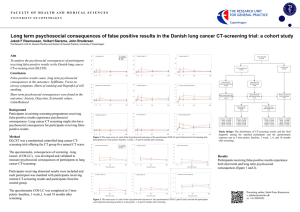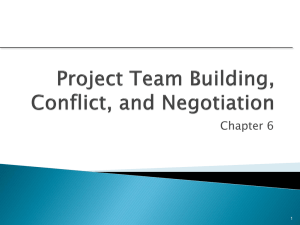A Guide to Psychosocial Safety Skills
advertisement
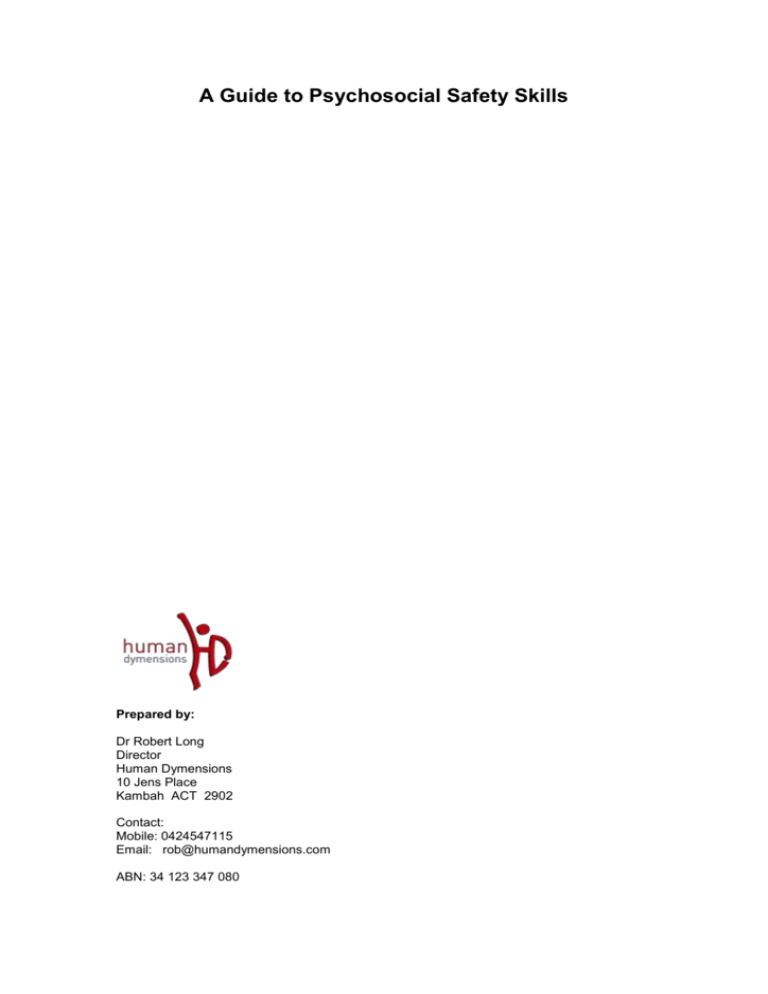
A Guide to Psychosocial Safety Skills Prepared by: Dr Robert Long Director Human Dymensions 10 Jens Place Kambah ACT 2902 Contact: Mobile: 0424547115 Email: rob@humandymensions.com ABN: 34 123 347 080 A Guide to Psychosocial Safety Skills Dr Rob Long Introduction Psychosocial safety is really not a new concept and has been around industry in various forms for some time. The beginnings of psychosocial safety are usually linked to Herbert W. Heinrich an insurance investigator in the 1930s and 1940s. Interest in psychosocial safety as a discipline grew out of the early work done by pioneers like Heinrich, who were applying behavioural principles in organizations. In the late 1960s and early 1970s, Aubrey Daniels, Wanda Myers, and others were working with organizations applying psychological concepts to improve performance in what Aubrey would later term ‘performance management’. More recently psychology in safety has been championed by Scott Geller (Geller, S., (2001) The Psychology of Safety Handbook Lewis Publishers, London). Perhaps the first complete focus on a psychosocial focus on risk and safety was triggered by the methodology of Karl E. Weick. Weick’s ‘psychosociocultural evolution model’ of organizing adapts the concepts and propositions of cultural evolution, sociology, psychology and ecology to human organizing, risk and safety. See further: Weick, K., (1979) The Social Psychology of Organizing McGraw Hill, New York; Weick, K., (1995) Sensemaking in Organisations Sage Publications, London. Psychosocial safety integrates key aspects of psychology and sociology to understand and manage human dimensions of safety. As a discipline, Psychosocial safety extends well beyond the mechanistic horizons of Behavioural Based Safety (BBS). Behaviourism is typically reductionist and determinist. Rather than being a panacea for safety BBS limits the way humans are viewed, humans are more than the sum of their behaviours and are not machines. For this reason psychosocial safety the takes into account a full range of psychosocial factors in its methodology not just behaviourism. The beginning of psychosocial safety is understanding that environment, context and culture influence human judgment and decision making. Whilst there is no doubt that orthodox safety methodologies such as BBS or legislation have some success in improving safety, there is much more to the safety picture if one wants to become a ‘Total Safety Organisation’ (Weick). The following serve as examples of what psychosocial safety considers in its response to human judgment and decision making about hazards and risks: Cognitive Dissonance: developed by Leon Festinger. Refers to the mental gymnastics required to maintain consistency in the light of contradicting evidence. An understanding of cognitive dissonance is essential if one wants to understand conversion. Cognitive dissonance explains the attempts made to alleviate the feeling of self-criticism and discomfort caused by the appearance of the conflicting beliefs. The idea that compliance forces, power, punishment, incentives and other behaviourist methods ‘convert’ people from ‘unsafety’ to safety is naïve. Such belief denies all that has been learned from the psychology of addictions, psychology of conversion, psychology of fundamentalisms, psychology of abuse, cults and religions, suicide ideation and psychology of goals (Moskowitz, G., and Grant, H., (eds.) (2009) The Psychology of Goals The Guilford Press, New York.). 2 Human Dymensions A Guide to Psychosocial Safety Skills Dr Rob Long In many ways televangelists and safety officers share something in common except televangelists are much better at it. They just have a different view of what it means to ‘save lives’. There is not space here to emphasise or map the dynamics of cognitive dissonance and its relevance to safety, I undertake a more detailed description of this in my book. Discourse Analysis: attributed to Leo Spitzer, Jurgen Habermas and Michael Foucault. Discourse analysis is concerned with The transmission of power in systems of thoughts composed of ideas, symbols, artefacts, attitudes, courses of action, beliefs and practices that systematically construct the subjects and the worlds of which they speak. For example: the language of safety is so important for the construction of meaning for organisations. For example: the language of ‘zero’ in safety constructs mindsets preoccupied with reductionism, minimalism and control. The language of BBS constructs a focus on behaviour-only approaches to safety. Reciprocal Determinism: postulated by social cognitive theorist Albert Bandura. Reciprocal determinism states: that the situation people find themselves in will influence both their behaviour and their attitudes. People’s behaviour will influence both their attitudes and the situation, and that people’s attitudes will influence their perceptions of a situation and, in turn influence their behaviour. Risk Homeostasis: developed by Gerald Wilde (Wilde, G., (2001) Target Risk 2 PDE Publications, 2001). Risk homeostasis holds that everyone has his or her own fixed level of acceptable risk. The famous Berlin Taxi Experiment first conducted by Wilde in 1981 demonstrates the idea of ‘risk compensation’. What this means is that people adjust their response to safety technologies. Safety technologies are not neutral but are interpreted. It is possible that some safety technologies increase rather than reduce risk. This is because humans tend to resist external controls and prefer to ‘own’ their decisions. The current thirst in society for ‘edgework’ exemplified in ‘X-games’ is evidence of risk homeostasis. Further see: Zinn, J., (ed) (2008) Social Theories of Risk and Uncertainty, An Introduction Blackwell, London. Unconscious enactment: championed by John Bargh. Bargh, J. A., (ed.) (2007) Social Psychology and the Unconscious: The Automaticity of Higher Mental Processes Psychology Press, New York; Hassin, R., Uleman, J., and Bargh, J., (2005) The New Unconscious Oxford University Press, London. Bargh shows that many of our decisions and judgments are ‘primed’ by the anchoring of words or social context. This idea of automaticity is also supported by social psychologists of risk: Slovic, Plous, Sunstein and Gardner. There are strong connections between what has been discovered by Bargh and discourse analysis. For this reason safety culture programs need to take much greater care with safety communications, language, words and symbols. Much more could be discussed about these and other psychosocial influences on human judgment and decision making. There is much more to learn about why some orthodox safety programs and initiatives don’t work. Psychosocial safety is no silver bullet, it just helps explain why there are no silver bullets. It extends the journey. Once we get our heads out of silver bullets and begin to 3 Human Dymensions A Guide to Psychosocial Safety Skills Dr Rob Long be realistic about human judgment and decision making, then we may better able to make sense of risk, broaden our approaches to its understanding, analysis and management. The Psychosocial Safety Maturity Index The psychosocial nature of safety commences where systems stop. This is represented graphically in the Psychosocial Safety Maturity Index (Figure 1). When someone steps beyond a systems-only response to risk, one commences the journey into psychosocial levels of understanding human judgments and decision making. Unless someone ‘steps’ up to embrace the complexities of psychosocial safety will remain in the mechanistic level of understanding risk in organisations. The first five steps in the maturity index whilst fundamental, fail to address the underlying drivers of human judgment and decision making. The five top levels in the safety maturity index indicate the nature of controls required to influence and manage psychosocial safety. Figure 1. The Psychosocial Safety Maturity Index High Reliability Organisation Total Safety Spectrum Sub-cultural Controls Cultural Controls Sociopolitical Controls Complexity Human Psychosocial Controls Behavioural and Cognitive Controls Systems Controls Technological Controls Engineering Controls Legislative Controls Administrative Controls Time 4 Human Dymensions A Guide to Psychosocial Safety Skills Dr Rob Long Key Concepts in Psychosocial Safety The following are critical to understanding psychosocial safety: 1. Active Listening: Active listening means suspending personal agenda and ‘attending’ to the issues and perspective of the ‘other’. One does not ask ‘open questions’ to get to ones own agenda but listens and then responds to what is said. This is the process of dialogue, “baited’ question and answer, even though there is verbal exchange, is still monologue. Carrying ‘hidden agenda’ psychologically interrupts the ability of listening in conversation. 2. Unconditional Positive Regard (UPR): UPR is about suspending judgment. It is amazing how our own biases and prejudice influence how we see the world and attribute risk. The beginning of UPR is acknowledgement of the other person, recognizing their worth and independence in decision making. It is an illusion to think you can control others, once you or the ‘policeman’ has left the scene they will exercise their decision making process. 3. Open questions: These are questions which help the other person tell a story or series of events. Closed questions just get abrupt short answers, usually just ‘yes’ or ‘no’. 4. Relationships: The key to longitudinal change and culture change is influencing thinking and behavior over time. One needs to earn the right to make judgments of another. Judgmentalism on its own achieves nothing but negativity. Bossing others, policing others and coercing others may work in the short term but creates dependence on the person in authority and discourages ‘ownership’. 5. Pitching: This is the decision made and strategy taken to engage another person. Pitching is often about the ‘style’ of engagement and what you think is the best ‘approach’ in ‘winning’ someone and influencing someone. 6. Framing: Any message you send to another is ‘loaded’. Messages are framed in the format of ‘gain’, ‘neutral’ or ‘loss’. Gain frames messages help other listen because the message shows them what they gain from the message. Loss frames messages are punitive in nature and tell the other how they will be punished for not accepting the message. Neutral messages generally carry no negative or positive value and are often statements of fact. 7. Priming: Priming is about the way our words, context, style, tone, appearance, language, discourse and environment ‘shape’ and influence the thinking of another. Priming is often about choosing what not to say as much as it is what to say. Priming acknowledges that there are ‘psychic forces’ at work in any exchange between people, this is established by all the research undertaken by Neuro Linguistic Programming (NLP). ‘Mirroring’ is a good example of the way others can be ‘primed’. 8. Values and ethical framework: Psychosocial safety recognizes that people make decisions and judgments on the basis of a host of influences. People chose to follow rules or break rules for good reasons, risk makes sense to them perhaps differently that us. It is one thing to talk about controls in a culture and the other to seek to ‘control’ others. Many of the social structures 5 Human Dymensions A Guide to Psychosocial Safety Skills Dr Rob Long we have in place which create belonging and identity strongly influence the ethos of the workplace. The best conversationalist is the one who ‘lets go’ of control and seeks to inform and influence others in a non-threatening and empowering way. 9. Creating doubt and dissonance: One of the key roles of the safety conversation is to create doubt and dissonance in the mind of the listener so that they might re-consider the way they assess a risk. Once the listener interrogates themselves and steps back from a course of thinking to reconsider, our job in conversation is done. 10. Learning and discovery: The best learning is when the listener ‘discovers’ something rather than being ‘told’ something. This is the best way to create ownership. The role of the conversationalist is to ‘facilitate’ new thinking in the mind of the other. The conversation is an exchange of discovery in how each is thinking about risk. Possible Problems 1. If in the course of a conversation or encounter you discover something that is a serious safety risk, stop the activity and assume the policeman mode. Then, explain why the action was taken and then get the other person to reflect on your choice. Leave on a specific positive. 2. Don’t confuse ‘passion’ and ‘rightness’ for influence, sometimes not knowing an answer is far more helpful than carrying a ‘loaded’ conversation. Doubt is a powerful mechanism for empowering others and reconsidering risk. Many people use their knowledge in safety and legislation to manipulate and play power games with others. This approach is most unsuccessful. An abusive style of ‘telling’ simply creates resentment and is a form of bullying. Justified bullying hidden behind regulations or legislation is still bullying. 3. Ensure your approach does not cause blaming or embarrassment. People do not respond well to being shamed or exposed by what someone says. Psychosocial Safety Concept Map The key to understanding psychosocial safety is to understand how context influences behavior and thinking. Psychosocial safety is therefore relational. The best way to represent the relational nature of psychosocial safety is through a concept map. Concept mapping shows the relationship between concepts and their interdependence. When the relationships between psychosocial elements are understood relationally then one can see how the approach takes on its own system of functioning. The following concept map seeks to explain the relational nature of psychosocial safety and the skills required to operate in this approach. 6 Human Dymensions A Guide to Psychosocial Safety Skills Dr Rob Long Human Dymensions - Psychosocial Safety Skills Map Systems Integration Listening Organisational Will/Energy UPR Attending Core values beliefs, attitudes Organisation Climate & Culture Motivations Psychic Forces Organisational Learning Organisational Psychology Systems Design Open Questions Relationships Community Pitching Framing PRIMING OHSE Marketting Gain Neutral Loss Autosuggestion Influencing Understanding Cognitive Dissonance Creating Doubt Risk/Hazard Controls Understanding Place & Space OHSE Communications Strategy OHSE Procedures OHSE Forms 7 Human Dymensions
